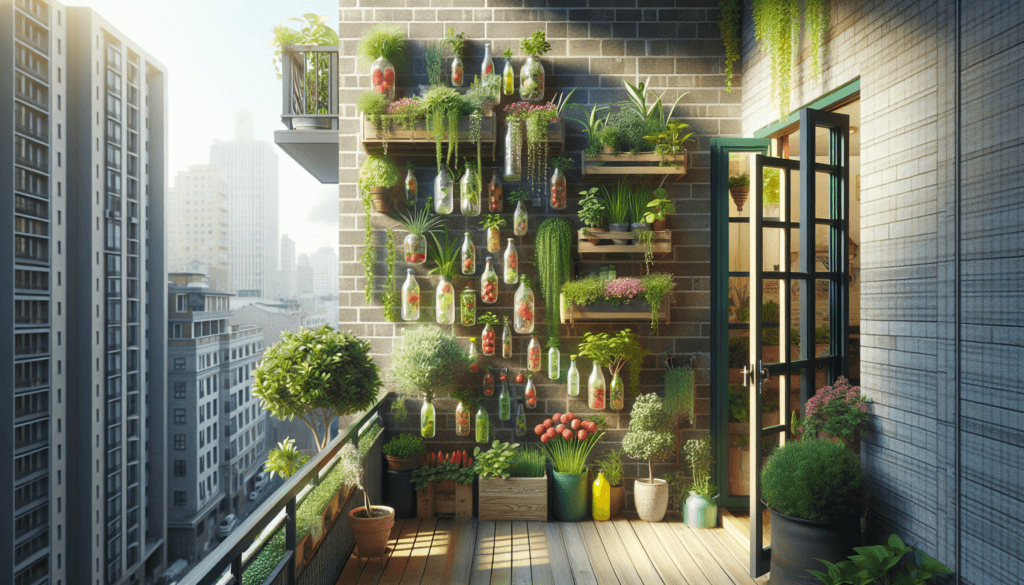Imagine transforming a tiny area in your backyard into a flourishing urban garden, filled with vibrant greens and fragrant blossoms. But before you grab your shovel and seeds, you might be wondering, “How much space do I actually need for an urban garden?” In this article, we will explore the space requirements for an urban garden, providing you with all the information you need to create your own little oasis of fresh produce and tranquility. So, roll up your sleeves and let’s dive into the world of gardening in limited spaces!

Choosing the Right Location
Considering Climate and Sunlight
When choosing a location for your urban garden, it’s crucial to consider the climate and sunlight exposure. Different plants have different sunlight requirements, so it’s important to assess how much direct sunlight and shade your potential garden location receives throughout the day. Additionally, consider the prevailing wind patterns in your area, as strong winds can damage fragile plants. By selecting a location that provides the right climate and adequate sunlight for your plants, you’ll set them up for success and ensure optimal growth.
Evaluating Soil Quality
The quality of the soil in your urban garden plays a significant role in the health and productivity of your plants. Conduct a soil evaluation to determine the soil’s composition and fertility. Test the pH levels, as different plants thrive in different pH levels. It’s also important to assess the soil’s drainage capabilities. Proper drainage is crucial to avoid waterlogging, which can lead to root rot and other plant diseases. By evaluating the soil quality, you can make necessary amendments to create an ideal growing environment for your plants.
Assessing Access to Water
Water is vital for the survival of your urban garden, so it’s important to assess the accessibility of water in your chosen location. Consider if you have a nearby water source, such as a tap or hose, that can easily reach the garden area. Additionally, evaluate the availability of water during dry periods, as plants require regular watering to thrive. If necessary, explore options such as rainwater harvesting or installing an irrigation system to ensure your plants receive the water they need for optimal growth.
Understanding Legal Restrictions
Before you proceed with starting an urban garden, it’s essential to understand any legal restrictions or regulations that may apply to your chosen location. Some areas have zoning laws or homeowner association rules that dictate what you can and cannot do with your property. Research local regulations and consult with relevant authorities to ensure you are compliant. By understanding the legal restrictions, you can avoid any unnecessary complications and ensure a smooth gardening experience.
Determining Garden Type and Size
Deciding on Container Gardening
Container gardening is a popular choice for urban gardeners with limited space or those looking for more flexibility. With container gardening, plants are grown in pots, planters, or other vessels, allowing you to easily move them around or adjust their placement as needed. This method is ideal for growing herbs, vegetables, or ornamental plants. Deciding on container gardening gives you the freedom to garden on balconies, rooftops, or even indoors by selecting suitable containers and ensuring proper drainage.
Opting for Raised Bed Gardening
Raised bed gardening is another excellent option for urban gardens. Raised beds are elevated planting areas built with a frame or container that holds the soil. They offer several advantages, such as improved drainage, better soil quality, and easier access for maintenance. Raised beds are particularly suitable for growing vegetables, herbs, or flowers. By opting for raised bed gardening, you can maximize your growing space while also enjoying the aesthetic appeal of well-defined garden beds.
Exploring Vertical Gardening
Vertical gardening is a space-saving technique that involves growing plants vertically instead of horizontally. This method allows you to utilize walls, trellises, or other vertical structures to grow plants upwards. Vertical gardening is perfect for climbers, vining plants, or those with trailing habits. By harnessing the vertical space in your urban garden, you can grow a wide variety of plants without sacrificing precious ground space. It also creates an eye-catching display that adds a unique dimension to your garden.
Considering Rooftop Gardening
If you have access to a rooftop or terrace, rooftop gardening can be a fantastic option for your urban garden. This type of gardening involves utilizing the available roof space to create a green and vibrant oasis. Before embarking on rooftop gardening, ensure that the structure can support the additional weight of the garden and make necessary arrangements for proper drainage. Rooftop gardens provide insulation, reduce the heat island effect, and offer stunning views. They’re an ideal choice for growing a diverse range of plants and creating a peaceful urban retreat.

Calculating Space Requirements per Plant
Identifying Plant Spacing Guidelines
Proper plant spacing is essential to ensure healthy growth and prevent overcrowding. Each plant has specific spacing requirements, which can vary depending on the species and growth habits. Research the recommended plant spacing guidelines for the crops or plants you intend to grow in your urban garden. Consider factors such as mature plant size, leaf spread, and root development when determining the appropriate spacing. By giving each plant enough space to thrive, you optimize air circulation and minimize competition for resources.
Accounting for Plant Height and Spread
In addition to plant spacing, it’s important to consider the height and spread of the plants when planning your garden layout. Taller plants can cast shadows and restrict sunlight access to shorter plants if not strategically positioned. Take into account the mature height and spread of the plants to ensure they won’t overshadow or hinder the growth of neighboring plants. By carefully arranging plants based on their size, you create a harmonious and visually appealing garden while maximizing space efficiency.
Measuring Space for Climbing Plants
If you plan to include climbing plants in your urban garden, ensure you provide adequate space for them to thrive and reach their full potential. Climbing plants, such as cucumbers, beans, or certain flowering vines, require trellises, stakes, or other support structures to grow vertically. Consider the height and spread of climbing plants when planning for these structures. Leave enough room for the plants to climb and spread out comfortably while also factoring in any potential shade they may cast on neighboring plants.
Planning for Companion Planting
Companion planting involves strategically pairing compatible plants that benefit each other when grown together. Some plants naturally repel pests, while others attract beneficial insects. By planning for companion planting in your urban garden, you can maximize space utilization and enhance plant health. Research companion plant pairings that work well for the crops or plants you intend to grow. By carefully selecting compatible plant combinations, you can create a thriving ecosystem that naturally deters pests and promotes plant growth.
Estimating Space for Walking Paths
Determining Width for Comfortable Passage
When designing your urban garden, it’s important to allocate space for comfortable walking paths between garden beds or other features. The width of these paths should allow easy movement and accessibility for you, as well as any visitors or maintenance personnel. Consider the types of plants you’re growing, as some may require wider paths for maintenance activities such as pruning or harvesting. Strive for a balance between maximizing space usage and ensuring comfortable passage throughout your garden.
Allowing Access for Maintenance
Maintenance is an integral part of gardening, so it’s essential to plan for easy access to all areas of your garden for regular upkeep. Ensure there is enough space around plants and garden features to perform tasks such as watering, weeding, or applying fertilizers. Take into account the reach of your gardening tools and equipment when determining the necessary access space. By allowing convenient access for maintenance activities, you’ll be able to keep your urban garden in excellent condition and promote plant health.
Creating Accessibility for Harvesting
One of the joys of urban gardening is being able to harvest fresh produce right from your own garden. When designing your garden layout, ensure that there is ample space for easy access to the plants when it’s time to harvest. Consider the size of the mature plants and the method of harvesting they require. Plants with sprawling growth habits, such as pumpkins or melons, may require more space around them for harvesting. By creating accessibility for harvesting, you’ll have a seamless experience enjoying the fruits of your labor.
Considering ADA Guidelines
If you want your urban garden to be accessible to individuals with disabilities, it’s important to consider the guidelines set forth by the Americans with Disabilities Act (ADA). ADA guidelines provide specifications for minimum accessibility requirements, including path width, slope gradients, and maneuvering space for wheelchair users. By incorporating ADA guidelines into your garden design, you ensure that everyone can enjoy and navigate your garden comfortably and safely.

Allocating Space for Seating and Recreational Areas
Designing Relaxation Spaces
Incorporating relaxation spaces in your urban garden allows you to create a tranquil retreat where you can unwind and enjoy nature. Whether it’s a cozy bench nestled amidst flowering plants or a hammock strung between trees, these serene spots offer an opportunity to rejuvenate. Consider the available space in your garden and design seating areas that provide a comfortable and inviting atmosphere. Choose materials and furnishings that are weather-resistant and suitable for outdoor use to ensure the longevity of your relaxation spaces.
Creating Social Gathering Areas
If you love hosting gatherings or inviting friends over, allocating space for social gathering areas in your urban garden is a must. Whether it’s a patio with dining furniture or a fire pit surrounded by seating, these areas provide a welcoming environment for socializing and entertaining. Consider the number of guests you typically host and plan for sufficient seating and open space. By creating social gathering areas, you’ll have a versatile outdoor space to enjoy with your loved ones.
Incorporating Play and Entertainment
If you have children or simply enjoy recreational activities, incorporating play and entertainment spaces in your urban garden can add an extra element of fun. Consider installing a swing set, sandbox, or even a mini soccer field to cater to various recreational interests. Designate areas that allow for safe and enjoyable play, ensuring that there is enough space for kids to move around comfortably. By including play and entertainment elements, you’ll create a vibrant garden environment that the whole family can enjoy.
Including Amenities like Benches or Tables
Practical amenities such as benches, tables, or picnic areas can enhance the functionality and convenience of your urban garden. Benches provide resting spots throughout the garden, allowing you to take a break and admire your plants. Tables can serve as workstations for gardening tasks or as spaces for family meals and gatherings. Consider the layout of your garden and identify suitable locations for these amenities. By including benches or tables, you create functional spaces that cater to different needs and activities.
Providing Space for Storage and Tools
Designating Storage Areas for Equipment
Every gardener needs storage space for tools, equipment, and supplies. Designate specific areas in your urban garden for storing gardening tools such as shovels, rakes, and hoses. Consider installing hooks, pegboards, or shelves for organizing smaller items like gloves, pots, and plant labels. By having designated storage areas, you ensure that your gardening essentials are easily accessible when needed, reducing clutter and promoting organization in your urban garden.
Planning for Compost and Mulch Storage
Compost and mulch are valuable additions to any garden, but they require adequate storage space. Plan for compost bins or tumblers to hold organic waste for recycling into nutrient-rich compost. Allocate space for storing bags or bins of mulch to retain soil moisture and suppress weeds. Consider the proximity of these storage areas to your garden beds for easy application. By including designated compost and mulch storage spaces, you promote sustainability and reap the benefits of these essential gardening elements.
Including Sheds or Toolboxes
If you have a larger urban garden or need extra storage space, consider including a shed or toolbox. Sheds provide ample storage for larger tools, equipment, and seasonal items like garden furniture or pots. Toolboxes are ideal for smaller gardens or for gardeners who prefer to keep their essentials portable. Evaluate the available space in your garden and choose the option that best suits your needs. By including sheds or toolboxes, you create functional storage areas that keep your gardening area tidy and organized.
Allocating Space for Potting and Washing Stations
Potting and washing stations are essential for various gardening tasks, such as repotting plants or cleaning garden tools. Allocate space in your urban garden for a potting bench or table, equipped with storage shelves for pots, potting soil, and other supplies. Ensure there is access to water nearby for washing purposes. By creating dedicated potting and washing areas, you streamline your gardening processes and maintain a clean and efficient workspace.

Considering Surrounding Structures and Landscaping
Accounting for Building Shadows
When choosing the location for your urban garden, consider any surrounding structures that may cast shadows and impact sunlight distribution. Buildings, walls, or nearby trees can block the sun and create shaded areas in your garden. It’s important to take note of these shadows throughout the day to assess their potential impact on plant growth. Position shade-tolerant plants in these areas and strategically arrange your garden beds to ensure that plants receiving direct sunlight have enough space for optimal growth.
Adapting to Existing Trees or Structures
If your urban garden is situated near existing trees, fences, or other structures, it’s crucial to adapt your gardening plans accordingly. Take into account the space required by the trees’ roots and branches, ensuring that they have adequate room to grow without obstructing your garden design. Consider using trellises or vertical gardening techniques to take advantage of walls or fences as additional growing areas. By adapting to existing trees or structures, you can maximize your garden space while harmonizing with the natural elements surrounding your garden.
Incorporating Hardscape Features
Hardscape features can enhance the visual appeal and functionality of your urban garden. Consider incorporating elements such as paved walkways, stone patios, or decorative walls. These features not only add aesthetic value but also provide structure and organization to your garden design. Plan for suitable materials that can withstand outdoor conditions and complement the overall theme of your garden. By incorporating hardscape features, you create a cohesive and captivating outdoor space.
Planning for Green Screens or Trellises
Green screens and trellises are excellent additions to any urban garden, especially if you’re looking to add privacy or create green walls. These structures can be used to support climbing plants or as vertical dividers in your garden. Research plant species that thrive in vertical conditions and plan for appropriate support systems. By planning for green screens or trellises, you can introduce an element of natural beauty and privacy to your urban garden while maximizing space utilization.
Factoring in Accessibility and Safety
Designing for Wheelchair Accessibility
To ensure inclusivity in your urban garden, it’s important to design pathways and garden features that are wheelchair accessible. Strive for smooth surfaces that accommodate wheelchairs and mobility aids comfortably. Avoid steep slopes, narrow passages, or uneven terrain that may pose challenges for individuals with mobility issues. Incorporate ramps or gentle gradients where needed and ensure adequate turning space for maneuverability. By designing for wheelchair accessibility, you create an inclusive garden environment that can be enjoyed by people of all abilities.
Ensuring Appropriate Lighting
Proper lighting in your urban garden is essential for safety and enjoyment, especially during evening hours. Consider incorporating various lighting options, such as solar-powered path lights, string lights, or spotlights, to illuminate walkways and highlight garden features. Ensure that pathways and seating areas are well-lit to prevent accidents and create a welcoming ambiance. By ensuring appropriate lighting, you can confidently navigate your garden after dark and prolong the time you can spend enjoying your outdoor space.
Considering Child and Pet Safety
If you have children or pets, it’s crucial to consider their safety when designing your urban garden. Choose plants that are non-toxic and avoid hazardous materials such as thorny bushes or poisonous pesticides. Install childproof gates or barriers to keep young children or pets out of designated areas where they might disturb delicate plants or encounter dangerous tools. By considering child and pet safety, you create a secure environment that can be enjoyed by your entire family, including furry friends.
Implementing Secure Fencing or Barriers
To protect your urban garden from unwanted intruders, whether they are animals or people, it’s important to implement secure fencing or barriers where necessary. Choose fencing materials that are appropriate for your garden’s style and purpose, be it decorative metal fencing or sturdy wooden panels. Ensure that the gates or entry points are secure and consider adding additional deterrents such as motion-sensor lighting or thorny shrubs near vulnerable areas. By implementing secure fencing or barriers, you create a sense of privacy and safeguard your garden from potential threats.
Assessing Maintenance and Sustainability
Determining Required Maintenance Effort
Before finalizing your urban garden design, assess the level of maintenance effort required to keep your garden healthy and thriving. Consider factors such as plant care, soil amendments, pest control, and irrigation requirements. Identify any specialized care needs of the plants you’ve chosen and evaluate if you have the time and resources to fulfill them. By determining the required maintenance effort, you can ensure that your garden remains vibrant and flourishing without becoming overwhelming.
Planning for Irrigation Systems
Efficient watering is crucial for the success of your urban garden, and planning for an irrigation system can help simplify this task. Evaluate different irrigation options such as drip irrigation, soaker hoses, or sprinkler systems, and choose the one that best suits your garden’s needs. Consider the water source, availability, and ease of installation when planning your irrigation system. By implementing an efficient irrigation system, you can save time and water while ensuring your plants receive the necessary moisture for healthy growth.
Incorporating Rainwater Harvesting
Rainwater harvesting is an eco-friendly practice that can supplement your irrigation needs while conserving water resources. Consider incorporating rain barrels or cisterns in your urban garden design to collect and store rainwater. Evaluate the available space for these storage containers and ensure that they are positioned to collect maximum rainfall. Implementing rainwater harvesting not only supports sustainable gardening practices but also reduces your reliance on municipal water supplies.
Considering Eco-friendly Practices
When planning your urban garden, it’s important to consider eco-friendly practices that reduce environmental impact. Explore options such as using organic fertilizers, practicing natural pest control, and minimizing water usage through mulching and efficient irrigation. Choose native plant species that are adapted to your local climate, as they require less water and maintenance compared to non-native plants. By considering eco-friendly practices, you contribute to a healthier ecosystem and promote sustainability in your urban garden.
Maximizing Space with Vertical Gardening
Exploring the Benefits of Vertical Gardening
Vertical gardening offers numerous benefits for urban gardeners with limited space. By utilizing vertical surfaces, you can make the most of your available space and grow a wide range of plants. Vertical gardening not only adds visual interest to your garden but also improves air circulation, optimizes sunlight exposure, and maximizes your yield per square foot. Embrace the advantages of vertical gardening and unlock the potential of your urban garden.
Choosing Suitable Vertical Structures
When implementing vertical gardening, it’s important to choose suitable vertical structures that can support the weight and growth habit of your selected plants. Consider options such as trellises, arbors, or wall-mounted planters. Ensure that these structures are securely installed and can withstand the elements. Additionally, evaluate the available space and select structures that complement the overall design of your garden. By choosing suitable vertical structures, you create a visually appealing and functional vertical gardening space.
Selecting Plants for Vertical Gardening
The choice of plants is crucial in successful vertical gardening. Select plants that are well-suited for growing vertically, such as climbing vegetables, vining flowers, or trailing herbs. Consider the growth habit, size, and maintenance requirements of the plants when making your selection. Opt for plants that are adaptable to your climate and sunlight conditions. By carefully selecting plants for vertical gardening, you create a bountiful and flourishing garden that maximizes your vertical space.
Utilizing Space-saving Techniques
In addition to utilizing vertical structures, employ space-saving techniques to further maximize your vertical garden’s potential. Consider techniques such as intercropping, where compatible plants with different growth habits are grown in close proximity to optimize space usage. Use hanging baskets or tiered planters to add layers of greenery and diversify your plant display. Embrace innovative solutions like using old pallets or repurposed materials as plant supports. By utilizing these space-saving techniques, you can create a dynamic and visually captivating vertical garden in your urban space.


